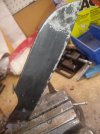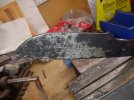- Joined
- Oct 10, 2018
- Messages
- 463
Good afternoon, everyone. I have a question about heat treating that does not seem to have many discussions. Does every oil quenching steel have scale that "pops off" from a successful quench?
I have quenched a couple knives of 8670 so far, and the scale is solid black with little to no shedding. Even after a 350 degree temper, it is extremely difficult for a file to dig in.
I have one of those cheesy Rockwell C files marked "60" and it can't do anything to either of the knives after grinding the scale off. The edge (~20 degrees with bte of ~.005) on the 1st one seems like it rolls a little after chopping a nail (haven't ground bevels on #2 yet). I broke the tip off and the grain structure seems a little sandy but not egregious, and that was after 3 quenches trying to get it right.
My process right now is:
Heat blade to non magnetic
Turn gas on forge down
Hold at roughly same color shade for 2.5 minutes (checking at intervals for magnetic to make sure my eyes aren't tricking me)
Tempered at 250 (edge chipping on brass rod and nail test), 300 (still a little chippy), then 350 (now rolling a little on both tests)
I arrived at soaking for 2.5 minutes after 1.5 and 2 did not seem to harden the knife. The edge is considerably tougher after the third quench but still rolls on hard use and if I push hard on the brass rod (springs back if I stay at sharpening angle).
But then there's that scale issue. Why isn't it acting like 1075 and 1084, unless it either didn't harden correctly or 8670 is a different animal. I'm leaning towards the former.
Thanks for reading that wall of text.
I have quenched a couple knives of 8670 so far, and the scale is solid black with little to no shedding. Even after a 350 degree temper, it is extremely difficult for a file to dig in.
I have one of those cheesy Rockwell C files marked "60" and it can't do anything to either of the knives after grinding the scale off. The edge (~20 degrees with bte of ~.005) on the 1st one seems like it rolls a little after chopping a nail (haven't ground bevels on #2 yet). I broke the tip off and the grain structure seems a little sandy but not egregious, and that was after 3 quenches trying to get it right.
My process right now is:
Heat blade to non magnetic
Turn gas on forge down
Hold at roughly same color shade for 2.5 minutes (checking at intervals for magnetic to make sure my eyes aren't tricking me)
Tempered at 250 (edge chipping on brass rod and nail test), 300 (still a little chippy), then 350 (now rolling a little on both tests)
I arrived at soaking for 2.5 minutes after 1.5 and 2 did not seem to harden the knife. The edge is considerably tougher after the third quench but still rolls on hard use and if I push hard on the brass rod (springs back if I stay at sharpening angle).
But then there's that scale issue. Why isn't it acting like 1075 and 1084, unless it either didn't harden correctly or 8670 is a different animal. I'm leaning towards the former.
Thanks for reading that wall of text.


